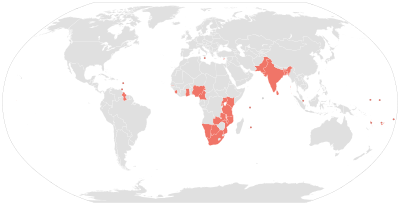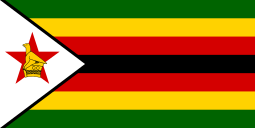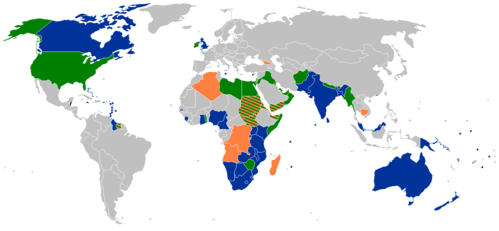Republics in the Commonwealth of Nations
The republics in the Commonwealth of Nations are the sovereign states in the organization with a republican form of government. As of 3 February 2020, 31 out of the 54 member states were republics. Elizabeth II, who is the monarch in the Commonwealth realms, is also still the titular Head of the Commonwealth organization (but not the head of the members of the Commonwealth) in a personal capacity, but this role does not carry with it any power; instead, it is a symbol of the free association of Commonwealth members.[1]

Except for the former Portuguese possession of Mozambique and the former Belgian trust territory of Rwanda, they are all former British (or partly British) colonies or self-governing colonies that have evolved into republics. Most of the Commonwealth's members achieved independence while keeping the British monarch as their own individual head of state (in a form of personal union) and later became republics within the Commonwealth by abolishing the monarchy. In some other instances, the countries became republics after achieving independence from other former British colonies (as Bangladesh did from Pakistan in 1971).
History
Republics have been allowed as members of the Commonwealth since the London Declaration made on 28 April 1949. Ten days before that declaration, the Republic of Ireland had been declared, ensuring most of Ireland's self-exclusion from the Commonwealth as republics were not allowed in the Commonwealth at that time (Northern Ireland, as part of the United Kingdom, remained within the Commonwealth). The Republic of Ireland did not re-apply for membership of the Commonwealth, despite being eligible to do so under the London Declaration.
The declaration was made by India to allow it to continue its membership of the Commonwealth despite its decision, implemented on January 26, 1950, to adopt a new Constitution and become a republic, abolishing the monarchy. Thus, India became the first republic within the Commonwealth. This set a precedent that all other countries were free to follow, as long as they each recognised the position of Head of the Commonwealth. A compromise between the Indian government and those, such as Jan Smuts,[2] who wished not to allow republics membership, the Declaration read:
The Government of India have ... declared and affirmed India's desire to continue her full membership of the Commonwealth of Nations and her acceptance of the King as the symbol of the free association of its independent member nations and as such the Head of the Commonwealth.[1]
Following their independence from the United Kingdom, most Commonwealth countries retained Queen Elizabeth II as head of state, who was represented in the country by a Governor-General. The monarch adopted a title to indicate individual sovereignty of each of these nations (such as "Queen of Barbados"). With time, many of these countries became republics, passing constitutional amendments or holding referendums to remove the monarch as their head of state, and replacing the governor-general with an elected or appointed president. This was especially true in post-colonial Africa. Most African realms became republics within a few years of independence. As of 2018, there are 16 states headed by Queen Elizabeth II, which are known as Commonwealth realms.
Commonwealth republics usually followed the presidential system. Some states became parliamentary republics, such as Malta or Fiji. In Fiji, the change to a republic in 1987 came as a result of two military coups, rather than out of any popular republican sentiment.
Even when Fiji was not a member of the Commonwealth, symbols of the monarchy remained, including the Queen's portrait on banknotes and coins; and, unlike in the United Kingdom, the Queen's Official Birthday is a public holiday. When Fiji was readmitted to the Commonwealth, the issue of reinstating the Queen as head of state was raised, but not pursued, although the country's Great Council of Chiefs reaffirmed that the Queen was still the country's "Paramount Chief".
Some republics within the Commonwealth became republics on gaining independence from the United Kingdom; again, this was particularly true in Africa.
While the moves to both independence and republican status have broken the remaining constitutional links to the United Kingdom, a number of Commonwealth countries have retained a right of appeal directly to the Judicial Committee of the Privy Council; for example, Mauritius, and (if the case involves constitutional rights) Kiribati. In contrast with Commonwealth realms and British overseas territories, however, such appeals are made directly to the Judicial Committee, rather than formally being made to "Her Majesty in Council".
Commonwealth membership
Within the Commonwealth, there is no differentiation in status between republics, Commonwealth realms and the members with their own monarchs (Brunei, Eswatini, Lesotho, Malaysia, and Tonga).
Membership of the Commonwealth is by common assent of the existing members, and this principle applies equally to territories gaining independence from the UK and to outside territories requesting membership. Until 2007, Commonwealth members that changed their internal constitutional structure to that of a republic had to re-apply for membership.[3] Widespread objection to the racial policies in South Africa resulted in that country deciding not to pursue a re-application for Commonwealth membership when it became a republic in 1961. South Africa was subsequently readmitted as a member of the Commonwealth after democratic elections in 1994. Fiji and the Maldives also did not apply for continued membership after becoming republics (Fiji was likely to be suspended in any case, since a coup had overthrown the democratically elected government), and thus their membership lapsed too.
Current republics in the Commonwealth
In some countries that became republics some time after independence, including Malta, Mauritius, and Trinidad and Tobago, the new office of President was a ceremonial post, usually held by the last Governor-General, each respective country being a Parliamentary republic. In others, such as Gambia, Ghana, and Malawi, the Presidency was an executive post, usually first held by the last Prime Minister, with each respective country being a Presidential republic. In the latter cases, not only was the monarchy abolished, but so was the entire Westminster system of parliamentary government as well.
List of Commonwealth republics
Republics on independence
In each case the republic was created through a new constitution.
| Member state | Year of independence |
Year of joining Commonwealth |
Type of president |
First president | Notes | |
|---|---|---|---|---|---|---|
| 1 | 1960 | 1961 | Executive | New appointment | ||
| 2 | 1961 | 1995 | Executive | New appointment | ||
| 3 | 1962 | 2009 | Executive | New appointment | Independent from Belgium from 1962 | |
| 4 | 1964 | Executive | Incumbent Prime Minister | |||
| 5 | 1965 | Ceremonial | Incumbent Governor (as a state of Malaysia) |
Formerly part of Malaysia from 1963 to 1965, when Singapore was expelled from Malaysia. | ||
| 6 | 1966 | Executive | Incumbent Prime Minister | |||
| 7 | 1968 | 2000 | Executive | New appointment | Became an independent republic in 1968, albeit, with special membership of the Commonwealth of Nations until 2000 | |
| 8 | 1971 | Ceremonial | New appointment | Formerly East Pakistan (1955–1971), previously a part of India as East Bengal. Upon independence it became part of Pakistan as part of the Partition Plan in 1947. | ||
| 9 | 1975 | 1995 | Executive | New appointment | Independent from Portugal since 1975 | |
| 10 | 1976 | Executive | New appointment | |||
| 11 | 1978 | Ceremonial | Incumbent Governor (interim) | |||
| 12 | 1979 | Executive | Incumbent Chief Minister | |||
| 13 | 1980 | Ceremonial | New appointment | |||
| 14 | 1990 | Executive | New appointment | Formerly a League of Nations Mandated Territory administered by South Africa. Continued to be de facto administered by South Africa until independence as South West Africa. |
Other republics in the Commonwealth
| Member state | Year of independence |
Became a Commonwealth republic |
Current government type |
First president | |
|---|---|---|---|---|---|
| 1 | 1970 | 1987 | Parliamentary republic | Incumbent Governor-General | |
| 2 | 1965 | 1970 | Presidential republic | Incumbent Prime Minister | |
| 3 | 1957 | 1960 | Presidential republic | Incumbent Prime Minister | |
| 4 | 1966 | 1970 | Presidential republic | Incumbent Governor-General (interim) | |
| 5 | 1947 | 1950 | Parliamentary republic | New appointment | |
| 6 | 1963 | 1964 | Presidential republic | Incumbent Prime Minister | |
| 7 | 1964 | 1966 | Presidential republic | Incumbent Prime Minister | |
| 8 | 1964 | 1974 | Parliamentary republic | Incumbent Governor-General | |
| 9 | 1968 | 1992 | Parliamentary republic | Incumbent Governor-General (interim) | |
| 10 | 1960 | 1963 | Parliamentary republic | Incumbent Governor-General | |
| 11 | 1947 | 1956 | Parliamentary republic | Incumbent Governor-General | |
| 12 | 1961 | 1971 | Presidential republic | Incumbent Governor-General (interim) | |
| 13 | 19101 | 1961 | Parliamentary republic | Incumbent Governor-General | |
| 14 | 1948 | 1972 | Semi-presidential republic | Incumbent Governor-General | |
| 15 | 1961 | 1961 | Presidential republic | Incumbent Prime Minister | |
| 16 | 1962 | 1976 | Parliamentary republic | Incumbent Governor-General | |
| 17 | 1962 | 1963 | Semi-presidential republic | New appointment |
1. The Union of South Africa was formed in 1910 as a semi-sovereign nation and associated state, then became fully sovereign in 1926 with the Balfour Declaration.
2. The United Republic of Tanzania was formed in 1964 from the merger of Tanganyika, which had gained independence in 1961 and became a republic in 1962, and Zanzibar, which had gained independence in 1963.
Republics formerly in the Commonwealth
Currently, the only former Commonwealth republics are:


Eligibility of other republics to join the Commonwealth

The 2007 Kampala review of the Edinburgh Declaration delimits the nations eligible for admission to the Commonwealth to those with "a historic constitutional association with an existing Commonwealth member, save in exceptional circumstances". Various republics have a historic association with the United Kingdom as being former British-administrated territories. The 2009 admission of Rwanda, which has no such association, was made under the "exceptional circumstances" proviso.[5]
The republics of South Sudan[6], Sudan[7], and Suriname[8] have formally made applications, while other republics have expressed interest.[9][10]
See also
References
- de Smith, S.A. (July 1949). "The London Declaration of the Commonwealth Prime Ministers, April 28, 1949". The Modern Law Review. 12 (3): 351–4. doi:10.1111/j.1468-2230.1949.tb00131.x. JSTOR 1090506.
- "1949–1999: Fifty Years of a Renewing Commonwealth". The Round Table. 88 (350): 1–27. April 1999. doi:10.1080/003585399108072.
- "Membership of the Commonwealth: Report of the Committee on Commonwealth Membership". Commonwealth Secretariat. 2007. Archived from the original on 31 January 2008. Retrieved 2 September 2008.
- "Zimbabwe officially applies to rejoin Commonwealth". Africanews. 21 May 2018. Retrieved 3 February 2020.
- "Rwanda: Joining the Commonwealth". The New Times. AllAfrica. 27 November 2009. Retrieved 29 November 2009.
- "South Sudan Launches Bid to Join Commonwealth". gurtong.net.
- Howden, Daniel (26 November 2009). "The Big Question: What is the Commonwealth's role, and is it relevant to global politics?". The Independent. London.
- "Welcome to Allvoices". allvoices.com. Archived from the original on 25 June 2013.
- Howden, Daniel (26 November 2009). "The Big Question: What is the Commonwealth's role, and is it relevant to global politics?". The Independent. London.
- Osike, Felix (24 November 2007). "Rwanda membership delayed". New Vision. Archived from the original on 23 January 2013. Retrieved 29 November 2009.